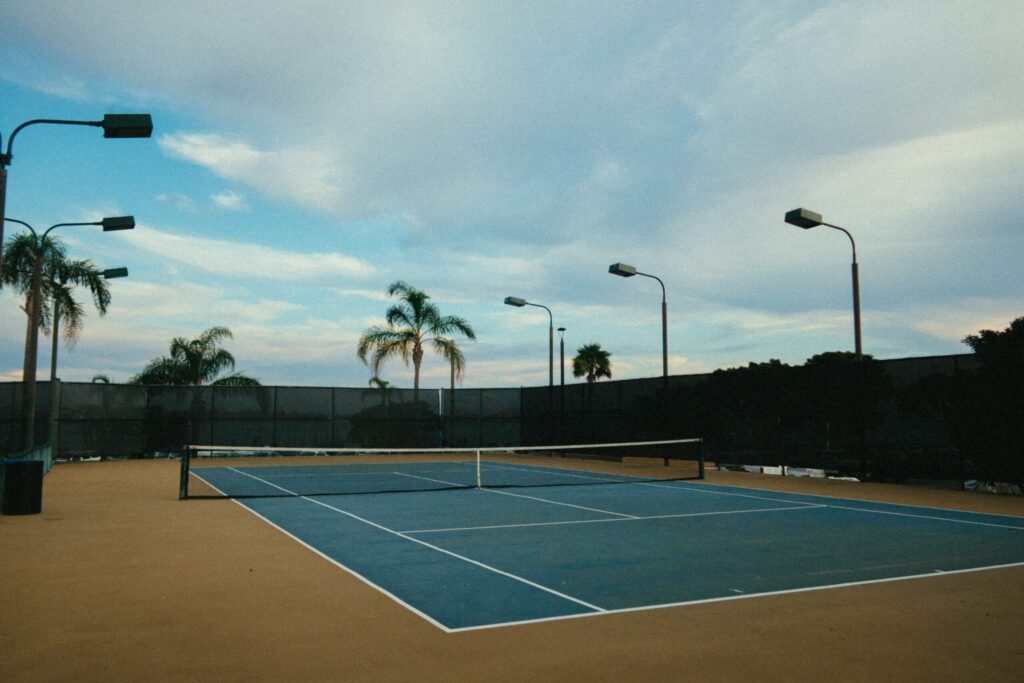Are you a tennis enthusiast dreaming of having your very own tennis court? Building a tennis court can be a thrilling endeavor, offering you the opportunity to practice and play whenever you desire. In this comprehensive guide, we will take you through the step-by-step process of tennis court construction, from planning and preparation to choosing the right materials and maintaining your court in top condition. Get ready to turn your dream into a reality!
Introduction: The Joy of Owning a Tennis Court
There’s something magical about having your own tennis court. Imagine stepping onto the court whenever you want, feeling the smooth surface beneath your feet, and indulging in the game you love. Whether you’re an avid player or simply enjoy hitting a few balls with friends and family, a personal tennis court provides the ultimate convenience and freedom. In this guide, we will provide you with all the information you need to embark on this exciting journey.
Chapter 1: Planning and Preparation
1.1 Assessing Your Space and Budget
Before diving into the construction process, it’s important to assess your available space and budget. Consider the size of your property, local regulations, and any existing structures that may need to be relocated. Determine your budget and allocate funds for various aspects such as materials, labor, and additional features.
1.2 Choosing the Right Court Surface
Selecting the appropriate court surface is crucial to ensure optimal playing conditions. Options include hard courts, clay courts, grass courts, and synthetic turf courts. Each surface has its own unique characteristics, maintenance requirements, and cost considerations. Evaluate factors such as climate, maintenance commitment, and personal preference when making your decision.
1.3 Hiring Professional Help
Tennis court construction is a complex undertaking that requires expertise in grading, drainage, and surface installation. Hiring a professional contractor experienced in tennis court construction is highly recommended. Research and gather quotes from reputable contractors, ensuring they have the necessary licenses and insurance.
1.4 Obtaining Permits and Regulations
Before proceeding with construction, check with your local authorities about the permits and regulations necessary for building a tennis court. They will provide guidance on zoning restrictions, setback requirements, and any other considerations specific to your area. Adhering to these regulations will ensure a smooth construction process and avoid potential legal issues.
Chapter 2: Construction Process
2.1 Site Preparation and Layout
Once you have obtained the necessary permits and finalized your plans, it’s time to prepare the site for construction. Clear the area of any vegetation, rocks, or debris. Work closely with your contractor to determine the best orientation and positioning of the court, considering factors such as sunlight, wind direction, and accessibility.
2.2 Excavation and Grading
Excavation is a critical step in the construction process. Your contractor will remove the topsoil and create a level playing field. Proper grading and compaction are essential to ensure a stable foundation. Additionally, the excavation phase allows for the installation of any necessary drainage systems to prevent water accumulation on the court surface.
2.3 Sub-base and Base Construction
The sub-base and base layers provide stability and support for the court surface. Your contractor will carefully prepare and compact the sub-base, typically using crushed stone or aggregate materials. The base layer follows, ensuring a smooth and even surface for the court construction.
2.4 Surface Installation (continued)
Synthetic turf courts feature artificial grass or turf infilled with sand or rubber granules. Your contractor will carefully install and level the surface material, ensuring proper compaction and smoothness. Paying attention to detail during this phase will result in a high-quality playing surface.
2.5 Markings and Accessories
Once the court surface is in place, it’s time to mark the lines and add essential accessories. Your contractor will accurately measure and paint the boundary lines, service lines, and other markings according to official tennis regulations. Additionally, the installation of tennis nets, posts, and any other court accessories will complete the construction process.
Chapter 3: Maintenance and Care
3.1 Regular Cleaning and Sweeping
To keep your tennis court in top condition, regular cleaning and sweeping are essential. Remove debris, leaves, and dirt from the surface using a soft-bristle brush or leaf blower. This prevents the accumulation of foreign materials that can affect ball bounce and court performance.
3.2 Resurfacing and Repairs
Over time, tennis court surfaces may experience wear and tear. Regular maintenance and periodic resurfacing will ensure the longevity of your court. Schedule professional resurfacing when the surface shows signs of cracking, fading, or significant wear. Address any repairs promptly to prevent further damage and maintain optimal playing conditions.
3.3 Seasonal Maintenance
Different seasons require specific maintenance measures. In colder climates, winterizing the court is crucial to protect it from freezing and thawing cycles. Proper drainage and covering the court can prevent damage caused by frost. In warmer climates, regular watering and shading can prevent excessive heat and sun damage.
3.4 Proper Court Drainage
Installing an effective drainage system during construction is vital for the longevity of your tennis court. Ensure that water is efficiently directed away from the surface, preventing waterlogging and surface damage. Regularly inspect and clean the drainage channels to maintain their functionality.
Chapter 4: Additional Considerations
4.1 Lighting Solutions
If you plan to play tennis during evening hours, investing in proper court lighting is essential. LED lights offer energy efficiency and excellent visibility. Position the lights strategically to eliminate shadows and provide even illumination across the court.
4.2 Fencing and Windbreaks
To enhance safety and privacy, consider installing fencing around the court. Choose a suitable fence height and material that meets local regulations and complements the aesthetics of your property. Additionally, windbreaks, such as windshields or screens, can be installed to reduce wind interference during gameplay.
4.3 Spectator Seating and Amenities
To create a comfortable and enjoyable environment for players and spectators, consider adding seating areas and amenities near the court. Install benches, shade structures, and water fountains to enhance the overall experience and encourage longer stays on the court.
4.4 Environmental Considerations
Incorporate eco-friendly practices into your tennis court construction and maintenance. Use environmentally friendly materials whenever possible, such as recycled or sustainable products. Consider rainwater harvesting systems for irrigation, and choose landscaping options that promote biodiversity.
Conclusion
Building your own tennis court is a dream come true for tennis enthusiasts. By following the steps outlined in this guide, you’ll be well on your way to constructing a high-quality court that will provide endless hours of enjoyment. Remember to plan carefully, hire experienced professionals, and prioritize proper maintenance to ensure your tennis court remains in excellent condition for years to come.
Now, it’s your turn to start building your dreams on the tennis court. Grab your racket, gather your friends and family, and enjoy the exhilarating experience of playing on a court that you can call your own.
FAQs
- Can I build a tennis court in my backyard?
Yes, you can build a tennis court in your backyard if you have enough space and comply with local regulations. Ensure you have the necessary permits and consult with professionals to determine the feasibility and requirements for your specific location.
- What is the ideal size of a tennis court?
The standard size for a tennis court is 78 feet long and 36 feet wide for singles matches, and 78 feet long and 27 feet wide for doubles matches. However, smaller court sizes can be considered for recreational or practice purposes.
- How long does it take to construct a tennis court?
The construction timeline depends on various factors such as site preparation, weather conditions, and the complexity of the project. On average, it can take several weeks to a few months to complete the construction process.
- How often does a tennis court need to be resurfaced?
The frequency of resurfacing depends on factors such as usage, climate conditions, and maintenance practices. As a general guideline, a tennis court should be resurfaced every 4 to 8 years to maintain its playability and appearance.
- How do I maintain my tennis court?
Regular maintenance is essential to keep your tennis court in optimal condition. This includes cleaning and sweeping the surface, addressing repairs promptly, and scheduling professional maintenance such as resurfacing when needed. Follow a maintenance schedule and consult with professionals for guidance on specific care requirements.


More Stories
How Lotus 365 India Simplifies Online Sports Betting for Beginners
Player Stats Preview: What to Expect from the Clippers vs Dallas Mavericks Game
Download Lotus365 India VIP Apk for Exclusive Betting Features and Casino Games